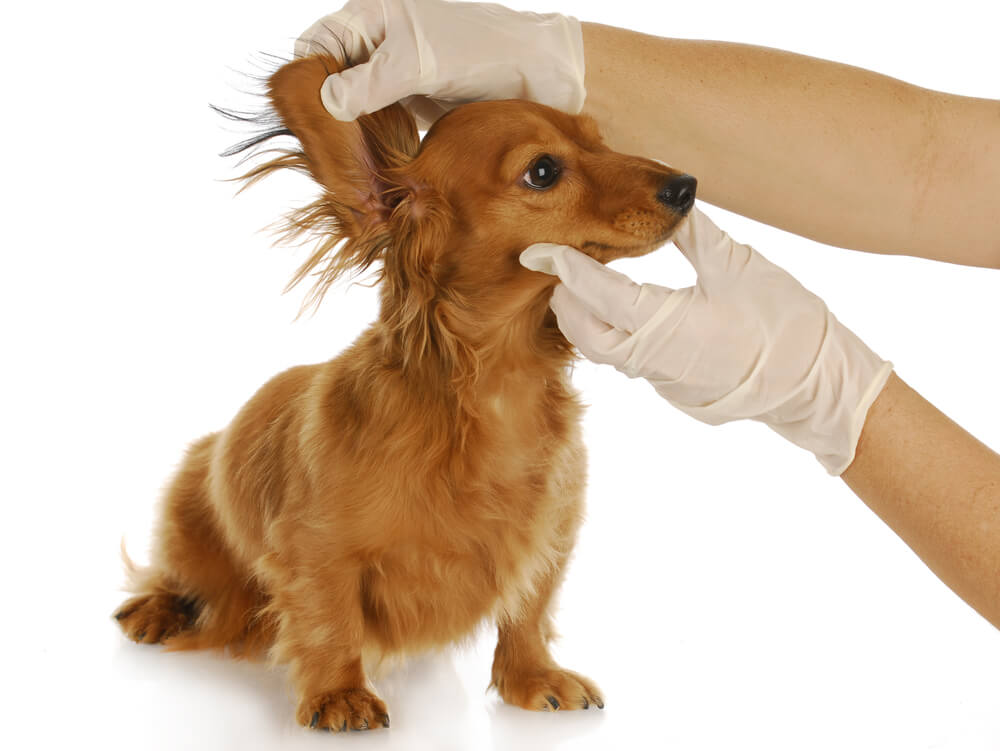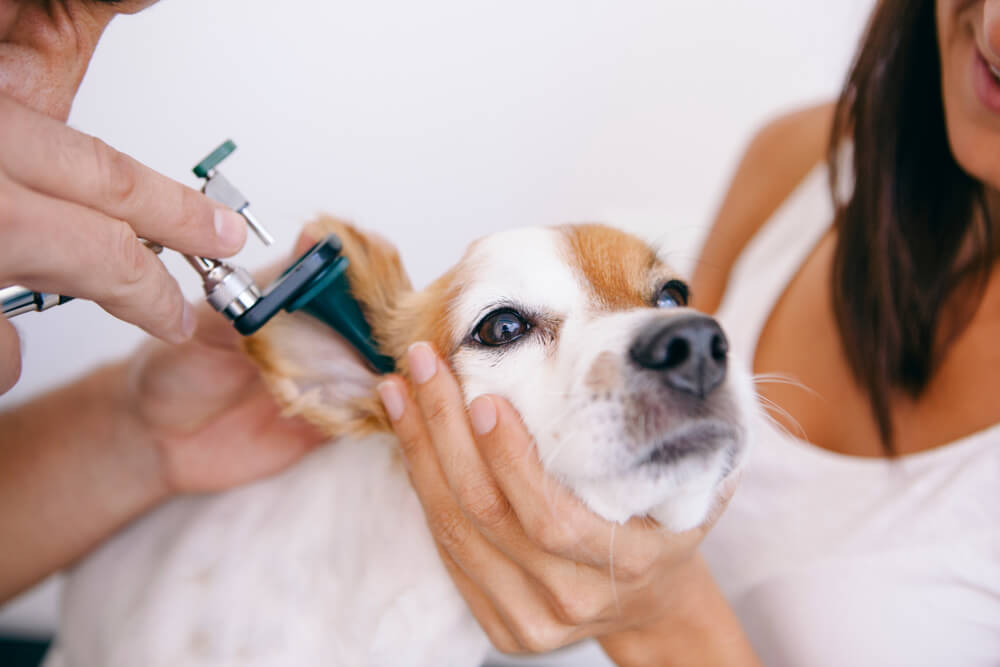
Itchy, smelly, and gross to look at, ear infections in dogs are a common problem that many pups and their parents struggle with. In this article, you’ll learn what ear infections in dogs look like, what causes them, common treatment approaches, and some frequently asked questions.
Signs of Ear Infections in Dogs
An ear infection in a dog may have some variation, but usually consists of a foul odor and discharge from one or both ears. This may be accompanied by varying degrees of inflammation and redness. The discharge itself may be light or dark in color and may be runny, thick, or crusty.
Some dogs may not show obvious signs of an ear infection until they get really bad. Pups that do show signs are often shaking and scratching more often, or rubbing their heads on the floor or walls of the home.
What Causes Ear Infections in Dogs?

An underlying allergy disorder from environmental allergens or food sensitivity can lead to inflammation in the ear canal.
In dogs, ear infections always have an underlying cause. This may include things like exposure to water from swimming or bathing, conformation/shape of the ear canal, or an underlying allergy disorder.
Dogs have ear canals which are much longer than those of people, and are shaped like an “L”. The length and shape lends to debris and microbial growth accumulating under the right conditions.
Water can get trapped in the lower ear canal, allowing bacterial and fungal yeast to overgrow in the warm, moist environment that results. Some dogs have more narrow ear canals that can exacerbate this issue.
An underlying allergy disorder from environmental allergens or food sensitivity can lead to inflammation in the ear canal and lead to overgrowth of bacteria and fungal yeast which are normally present.
Some dogs with floppy ears may be more prone to ear infections not just because of differences to their ear canals, but also because the coverage of the ear canal may lead to a pet parent taking longer to recognize that an infection is present.
Fortunately ear infections in dogs are not contagious and cannot be passed from one dog to another. They are always the result of a dog’s own microorganisms overgrowing under the right conditions, or from bacteria introduced from scratching an already itchy ear.
How to Get Rid of Ear Infections in Dogs
Overall, the best way to get rid of a dog ear infection is to seek proper veterinary care. This is to make sure the diagnosis is correct in terms of what type of infection is present so that the correct medication and ear cleaners can be used. Your vet will also help determine the underlying cause for your dog’s ear infections, especially if they tend to recur.
In some cases, a treatment over the counter or approved home remedy may be used if you’re able to recognize the very early stages of an ear infection. Some enzymatic cleaners with a mild steroid developed for dogs may keep an early infection at bay, especially if it’s related to an allergy flare-up.
But if your pup’s ear isn’t looking better after 2-3 days, it’s always best to get your friend into the vet to have things evaluated. And you do have to be very careful about using home remedies, like ones that include vinegar solutions as these can be more irritating if your pup has inflamed ears. Always avoid hydrogen peroxide or alcohol as a home remedy in your pup’s ears.
Want to know how to keep your pup from getting an ear infection in the first place? Make sure to check out the article we wrote titled: How to Prevent Ear Infections in Dogs.
How Do Vets Treat Ear Infections in Dogs?

Your vet will obtain a sample from both ears to evaluate under a microscope to see what type of organisms are causing the infection.
When you bring your pup to the vet with an ear infection, there are some common steps that take place.
First, your vet examines your pet’s ear canals to evaluate their appearance, rule out ear mites, and ensure that the eardrum is intact.
A sample is then obtained from both ears to evaluate under a microscope to see what type of organisms are causing the infection. Fungal yeast and different bacteria can both be involved, and your vet can tell if the infection is light or heavy based on the samples.
Your vet will prescribe the proper medication to use for your dog’s ear infection and often a cleaner as well. Ear cleaners can have different benefits for different types of infections, so it’s always best to use a cleaner your vet recommends along with medication.
Because ear infections always have another underlying cause, your vet will discuss what those possibilities may be. If ear infections recur often in your dog, a discussion about environmental or food allergies is likely to come up. Additional medication to control an underlying allergy may be recommended, as well as changes in diet if a food allergy is suspected.
If a food allergy is thought to be present, feeding your dog a limited ingredient diet can be helpful because reducing as many dietary variables as possible is important to rule out a culprit.
Food protein allergies are often implicated, so looking at less common protein sources like turkey or pork and avoiding dairy, soy, & wheat gluten can be helpful.
If left untreated, chronic ear infections can lead to permanent changes in the ear canal like swelling and thickening, that ultimately may not be reversible and can require surgery.
What’s the Best Way to Clean My Dog’s Ears?

The best way is to insert a squirt or two of solution, then massage and squish the base of the ear, and only afterward use cotton balls.
The best way to clean your pup’s ear is to insert a squirt or two of solution, then massage and squish the base of the ear. This helps to loosen debris adhered to the walls of the ear canal.
After your pup gives a good shake, use cotton balls to clean out what you can see. While cotton swabs can be used to clean out the many intricate folds of the ear, don’t use them at home to clean deeper in the canal. This may only push material further down the ear and cause risk to the sensitive eardrum.
Frequently Asked Questions
What Causes Ear Yeast Infections in Dogs?
In nearly all cases, fungal yeast ear infections are caused by food allergies or an underlying environmental allergy. Unlike bacteria, yeast do not commonly exhibit resistance to antifungal medications, so their persistence means that the allergy disorder has not been fully addressed.
What Foods Cause Ear Infections in Dogs?
There is not one single food or group of foods that cause ear infections. Some dogs with allergies to certain ingredients can develop skin and ear allergy conditions that contribute to recurrent ear infections.



